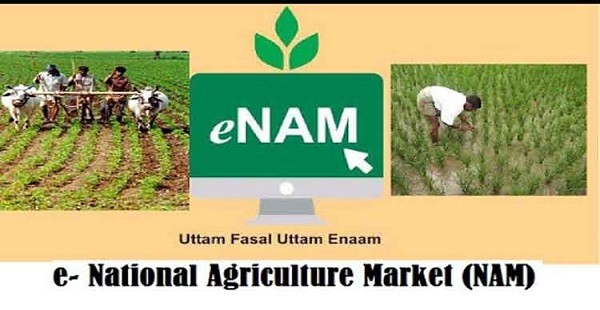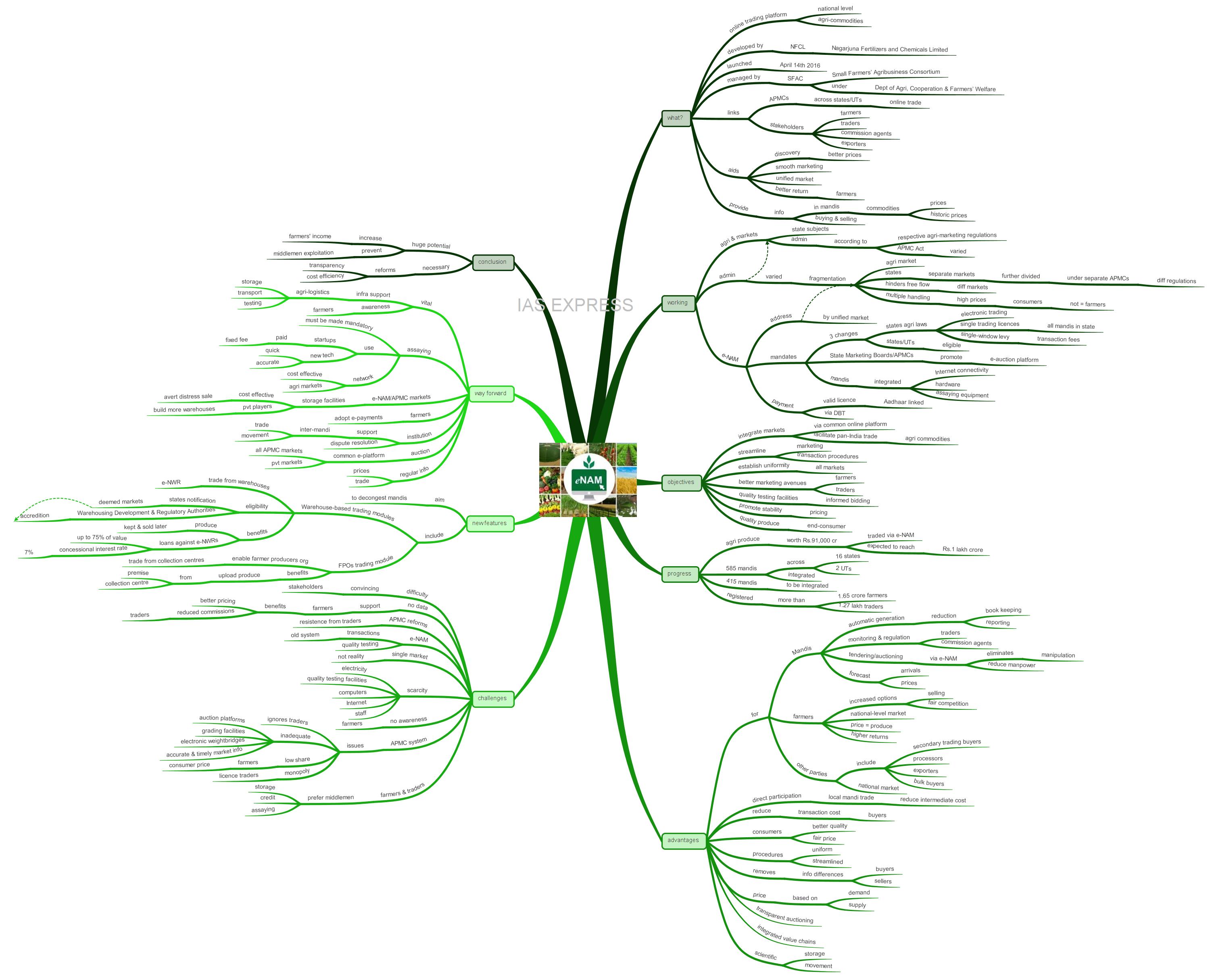National Agriculture Market (e-NAM): Objectives, Working, Advantages, Challenges

From Current Affairs Notes for UPSC » Editorials & In-depths » This topic
IAS EXPRESS Vs UPSC Prelims 2024: 85+ questions reflected
National Agriculture Market (e-NAM) has recently been updated with two new software so that farmers need not have to travel a long distance to sell their harvest. Through the new updates, the farmers will be able to access buyers through the mobile software from the nearest warehouses and will be able to connect to the e-NAM from their own collection centres. Currently, e-NAM faces several issues due to both the lack of cooperation from the local governments and parties involved and also due to the limitations in the availability of supportive infrastructures.
What is e-NAM?
- National Agriculture Market (e-NAM) is a pan-India online trading platform for agricultural commodities developed by Nagarjuna Fertilizers and Chemicals Limited (NFCL).
- Launched on April 14th 2016, it is driving agricultural trade towards the objective of remunerative prices for farmers by plugging the rampant trade malpractices in mandis.
- It is managed by Small Farmers’ Agribusiness Consortium (SFAC) under the Department of Agriculture, Cooperation and Farmers’ Welfare.
- It links agricultural produce market committees (APMCs) across all states with online trading of commodities.
- While the farmer is the primary stakeholder, e-NAM also provides traders, commission agents and exporters with better business opportunities through a unified and extensive market place.
- It aims to help them discover better prices and facilitates for smooth marketing of the products through mobile and web applications.
- This is done by providing information and services related to agri-commodities:
- The commodities that are available in various mandis along with their prices
- The historical prices of various commodities
- Buy and sell trade offers for these commodities
- Through the aforementioned information, e-NAM helps farmers bargain a better return for their produce.
- The traders and farmers should register themselves with the portal to have access to its services.
How does e-NAM work?
- Administration of agriculture marketing is carried out by respective states according to their agri-marketing regulations as agriculture and markets are state subjects under the Indian constitution.
- Each state has its own APMC Act, with varied provisions.
- The lack of uniformity and compatibility has led to the fragmentation of agricultural markets, where each state functions as a separate market.
- Every state is further divided into several market areas.
- These separate areas formed will be administered by a separate Agricultural Produce Marketing Committee (APMC), which imposes its own marketing regulation.
- This fragmentation of markets even within the state level hinders the free flow of agri-commodities between different markets.
- Multiple handling of agri-produce and multiple levels of mandi charges lead to escalated price for the consumers without equivalent benefits for the farmers.
- These challenges are addressed by e-NAM by creating a unified market via online trading platform both at the state and at the national level.
- For seamless operations, e-NAM mandates three changes in the agricultural marketing laws of states. This include:
- Provide for electronic trading
- Provide single trading licences that are valid in all mandis in a state
- Provide a single-window levy of transaction fees
- Only the states/UTs that have completed these pre-requisites will be eligible for assistance under this scheme.
- Also, the State Marketing Boards/APMCs must enable the promotion of e-auction platform.
- The states must also ensure that the mandis are integrated with NAM through internet connectivity, hardware and assaying equipment.
- The payments for the farmers will be provided with valid licence linked with Aadhaar through Direct Benefit Transfer by state APMCs.
What are the objectives of e-NAM?
- To integrate markets, at the state-level and national-level through a common online platform that would facilitate a pan-India trade in agricultural commodities
- To streamline marketing and transaction procedures and establish uniformity across all markets within the country to promote the efficient functioning of these markets
- To enhance better marketing avenues for both the seller (farmers) and the buyers (trader)
- To put in place quality testing facilities that would help in better-informed biddings by buyers
- To promote stability in pricing and ensure the availability of quality products to the end-consumer.
What is the progress made by e-NAM?
- Agriculture produce worth Rs.91,000 crore has been traded through the e-NAM platform so far and the figure is soon expected to reach Rs.1 lakh crore.
- Currently, 585 mandis across 16 states and 2 UTs have been integrated on the platform.
- 415 mandis are expected to integrate with e-NAM soon.
- More than 1.65 crore farmers and 1.27 lakh traders have registered.
What are the advantages of e-NAM?
For Mandis:
- A reduction in bookkeeping and reporting system as they are now generated automatically.
- Better monitoring and regulation of traders and commission agents
- A completely transparent system that eliminates scope for intentional or unintentional manipulation of tendering/auctioning process
- As tendering/auctioning process takes place through e-NAM, manpower requirement is reduced
- It can be used to forecast the arrivals and prices
- Availability of the activities of each APMCs is on the government website.
For Farmers:
- E-NAM provides improved and increased options for selling produce, leading to fair competition within the market.
- It allows farmers to have access to the national-level market with prices based on the quality of their produce
- It provides higher returns for farmers
For other parties:
- E-MAM provides access to larger national markets for secondary trading buyers, processors and exporters
- Bulk buyers, processors, exporters etc., can participate directly in trading at the local mandi level, thereby reducing their intermediation costs.
- Transaction costs are also reduced for the buyers
- Consumers are provided with a better quality of produce at more reasonable prices
Other benefits:
- E-NAM provides uniformity and streamlining of procedures across the nation
- It removes information differences between buyers and sellers by providing real-time price estimates
- based on the demand and supply
- It provides for transparent auctioning
- It facilitates integrated value chains in major agricultural commodities across the country and helps to promote scientific storage and movement of agri-commodities.
What are the challenges faced by e-NAM?
- Governments are facing difficulty in convincing all the stakeholders like farmers, traders etc., move to the online platform
- In Maharashtra, Haryana and Bihar, it is found that any reform in APMC system is facing stiff resistance from traders.
- Though the government claims that around 1 crore farmers are using the e-NAM platform, the ground reports suggest that most of the transactions recorded on e-NAM were conducted through the old system and that a single market for the nation is still not a reality.
- There is no evidence to suggest that farmers have gained from this new system in terms of reduced commissions to traders and/or better returns for their produce.
- The scarcity of electricity, computers, internet facilities and a shortage of staff and sorting and quality testing facilities also remains a huge challenge for this scheme.
- Lack of awareness of the e-NAM scheme among the farmers prevents them from adopting the same.
- Some of the issues with the APMC system are as follows:
- It ignores the role of traders completely
- Inadequacy in marketing infrastructure like scarcity of covered and open auction platforms, grading facilities, electronic weighbridges, lack of accurate and timely market information etc.
- Limited access to agriculture produce markets
- The monopoly of licence traders
- The low share of farmers in the consumer price
- A major drawback that exists in e-NAM is that for a trader to bid from another location, there is a need for a reliable way to assess the quality of the produce.
- It is impossible to assay all the arrivals and the majority of the traders prefer and trust visual inspection by their own agents.
- Traders are also reluctant to ensure immediate online payment until they receive the goods. Traditionally, the commission agents absorbed these risks by paying farmers and getting paid by traders after delivery.
- Both farmers and traders are preferring intermediaries for their critical role in storage, credit and assaying.
What are new features added to the e-NAM?
- The government has recently launched new features in the e-NAM platform to strengthen agriculture marketing by farmers to reduce their need to physically come to wholesale mandis for selling their harvested produce
- These reforms come amid the increasing need to decongest mandis to effectively fight against COVID-19.
- The two new features are as follows:
- Warehouse-based trading modules in e-NAM software will enable trade from warehouses according to e-NWR (electronic negotiable warehouse receipt)
- Farmers Producers Organisations (FPOs) trading module in e-NAM enables FPOs to trade their produce from their collection centres without bringing the produce to APMC.
- These new features make it more convenient for the farmers to sell their produce at warehouses and collection centres established by farmer producer organisations (FPOs).
- Warehouses that are accredited by the Warehousing Development and Regulatory Authorities are the only ones eligible to provide the trading services once the states notify them as deemed markets.
- This additional option would help farmers to access the e-NAM platform via the warehouses as they can keep their produce and sell it later when the prices will be higher since storage cost is low.
- Even small farmers can easily take loans against e-NWRs, generally up to 75% of the value of crops, at a concessional interest rate of 7% to meet their immediate needs.
- Also, the FPOs trading module will help these FPOs to upload their produce from their premises/collection centres for bidding
What can be the way forward?
- The government should also ensure that farmers adopt this mechanism and do away with their traditional interactions with the traders.
- Startups should be allowed to test the quality of the produce. They should get paid at a fixed fee.
- The government can also ensure the development of a network of cost-effective assaying facilities in agricultural markets across the country for all commodities.
- The e-NAM mechanism should include state-of-the-art technologies to enable quick and accurate assaying at a reasonable cost.
- Assaying should be made mandatory for transactions under e-NAM.
- It is necessary to ensure that e-NAM/APMC markets have appropriate storage facilities to provide cost-effective warehousing facilities to farmers to avert distress sale.
- Private players can be invited to build more warehouses at the site of mandis.
- Electronic payments should be adopted so that farmers get prompt payment from their produce.
- An institution should be established to support inter-mandi trade and movement of produce. This institution should also be involved in dispute resolution.
- Auction of the produce should take place simultaneously on one common electronic platform in all APMC markets in the country, as well as in the private market.
- There should be a regular flow of information on prices and trades executed on e-NAM so that integration of the market is achieved.
- In order to ensure that the buyers from across the country, irrespective of the location, can buy produce from any part of the country, necessary agri-logistics infrastructure for storage, testing and transportation should be put in place.
Conclusion:
e-NAM has a huge potential to increase the farmer’s income and prevent exploitation by middlemen. To realise this, it is necessary to undertake reforms to ensure transparency and cost-efficiency of the mechanism is achieved.
Practice question for mains:
What are the issues faced by e-NAM? What are the reforms that need to be taken to ensure that its full potential is utilised by all parties involved?
If you like this post, please share your feedback in the comments section below so that we will upload more posts like this.


